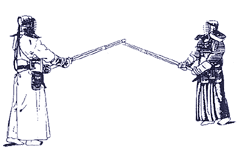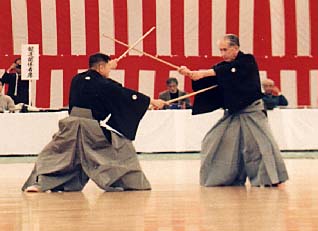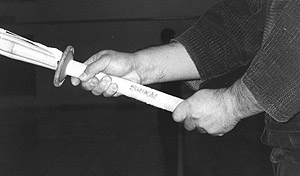Can we relate Niten Ichiryu to other martial arts either old or new?
Seeing so many questions and answers on forums. Reading articles by people that might be considered to be an authority on the subject prompts me to write a little. But at he same time not wishing to take away anyone's inspiration.
I like many others am a Yudansha in Kendo, Iaido and Battojutsu. But the difference is I am also a senior member and national representative of the Hyoho Niten Ichiryu. It is with this experience that I feel I should try and shed some light on the distinct differences I see and was taught by two sohke.
To make things simple I would like to quote from a recent article to try an make things clearer.
One article likening Gorin no Sho to modern Kendo takes quotes from an English translation of Gorin no Sho as follows:
Regarding position: There is a mention of keeping the head erect without leaning forward or backward . Keep the neck straight with the scruff tense. Below the shoulders, the tension should be even throughout the body. Shoulders low neck straight without pushing the buttocks out etc. Up to now does this sound familiar and could it relate to this picture? |
 |
I would definitely say "yes". To continue with Gorin no Sho quote; Tense your legs from the knees to the toes. Push your stomach forward so that you do not bend at the hips.
Does it still relate? Sadly no. The fact of the matter is reading alone is far from sufficient. There is a tremendous “grey area” that can only be filled in by oral and practical teaching. A transmission that makes the whole thing as one. You can clearly see the stance with legs and arms flexed uses a completely different set of muscles to generate forward body power which usually incorporates an avoiding action. Look at the finishing angle of the arms in relationship to the opponent. The theory behind this is this it provides a chance to further extend should the opponent move back. |
 |
Lets go on to examine another quote with regards to grip: In holding the sword it is important to place the least tension on your thumb and index finger while pressing the middle finger a little harder. The remaining two fingers should be pressed on the sword. at the moment you strike your opponent you must maintain the same grip by adjusting the thumb and forefinger etc.
 |
Reading the text one would assume it applies to this. |
| But this is what it refers to. You will notice that the tsuka is well tucked under the muscle indicated by red arrow. This activates the muscles underneath the ulna (green arrow) not the muscles used in Kendo. This also has a distinct effect on te no uchi as the hands do not twist over locking the wrist joints. This is of course like the picture above a standard view. Upon cutting the method of ten-no uchi again differs. In the Hyoho Shiji ni Kajo there is a clear mention of protecting ones own body area. For this reason the hands and arms always stay inside the bodies width. |
As to the philosophy.
The concept of Kendo is to discipline the human character through the application of the principles of the Japanese sword.
Musashi's concept was, “Since we are born and live on this earth we should
face God and give birth to children and increase the human race and make everybody
happy. In order to do this we have to face the unavoidable and our fatality".
His ideal was "To learn the sword we must learn the heart”. Learn
the heart and you will never need to pick up a sword!
We see a mention of Mitsu no sen. But this was to help us understand the principles of other sword styles. In actual fact Mitsu no sen is not practiced by the Hyoho Niten Ichiryu. Only "Sen". By all means its wonderful to read Musashi. But at the same time don't take what he writes too literally in application to other Budo. That can only come from practice in conjunction with reading.
The work Gorin no Sho written by Musashi is most ambiguous. Translating it into English make its even more so. This is why its possible to put out so many translations of it all having some variation. His very full details of techniques in Hyoho Shiji ni Kajo offer us a far more detailed description of his waza. Add to this his philosophical outline in Dokkodo that can be expounded into infinite detail by studying the Buddhist quotes within and we to get a far fuller picture.